Flying a national treasure—the SBD Dauntless
Anchors aweigh: 100 years of naval aviation—A GA pilot’s perspective
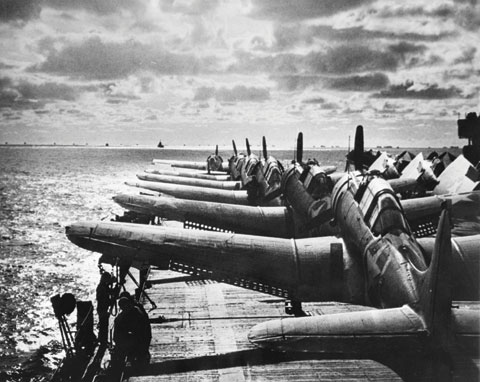
Perhaps no aircraft has played a more notable role in the first century of U.S. naval aviation than the ungainly, iconic SBD Dauntless.
Already technologically obsolete at the start of World War II, the SBD fought through to the end, and the two-man aircraft assured its place in history by delivering the single most devastating blow against the Japanese fleet on June 4, 1942, when 33 SBDs sank four aircraft carriers at the pivotal Battle of Midway.
For a modern-day general aviation pilot, flying an SBD hints at the skills and fortitude U.S. Navy and Marine aviators must have had to do what they did so many times: launch from aircraft carriers, navigate over a featureless ocean, dive vertically from 18,000 feet to the surface of the waves, pull up to nine Gs—and hope to avoid bomb fragments, antiaircraft fire, and enemy fighters. If successful, of course, all that remained was finding their way back to the carrier and landing.
My chance to fly an SBD as PIC came via the Commemorative Air Force—a volunteer group dedicated to the preservation of former U.S. military aircraft. I had s 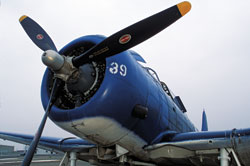 een their restored SBD at the Atlanta wing’s home base at Peachtree City’s Falcon Field and found out what it would take to fly it: a $5,000 donation to the CAF, relevant flight experience, and three checkrides (two in a North American AT–6/SNJ and one in the SBD). Soon the check was written, and I was on my way.
een their restored SBD at the Atlanta wing’s home base at Peachtree City’s Falcon Field and found out what it would take to fly it: a $5,000 donation to the CAF, relevant flight experience, and three checkrides (two in a North American AT–6/SNJ and one in the SBD). Soon the check was written, and I was on my way.
The first test was a backseat T–6 checkout with John “Skipper” Hyle, a former F–16 pilot and current airline captain in Atlanta, which included lots of landings and a few unusual attitudes and simulated emergencies. It continued a few weeks later with a trip to Midland, Texas, for an interview with CAF officials, and a second T–6 checkride with Randy Wilson, a member of the organization’s Sky High Wing.
The CAF classifies the SBD as a “fighter,” so flight evaluations take place in the T–6 and aspiring pilots must have logged 200 hours in the demanding trainers. That wasn’t much of a hurdle for military pilots of a certain era, but for a civilian flier like me—born in 1961—it was pure luck that I met the T–6 flight time requirement. David Peeler of Memphis, Tennessee, had allowed me to use his T–6 for my FAA commercial pilot checkride years ago when his T–6 was the only “complex” airplane I’d ever flown. Then, in Atlanta, I’d stumbled into a dream job on the weekends giving aerobatic rides in Steve Collins’ T–6. So, through no planning or ambition on my part, I met the magic number.
The Midland checkride was particularly enjoyable because Wilson is a patient teacher and an aerobat at heart. The hour-long flight included low-speed loops (started at a critically slow 150 mph IAS), incipient spins, and a variety of stalls that test a pilot’s ability to recover from sudden departures.
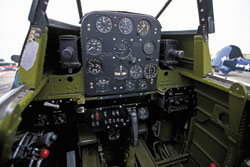 Then it was back to Atlanta to fly the SBD with Jim Buckley, the Dixie Wing’s chief pilot. Buckley, a retired airline pilot and aviation mechanic, implicitly understands big radial engines, cantankerous old airframes, and pilots. When I showed up at the Dixie Wing’s hangar on a cool, crisp September morning, I walked straight to the airplane. I had read and reread the manual, and I couldn’t wait to launch into the still morning air. Buckley recognized my overeagerness and directed me out of the hangar, then sat me down in an office for several hours of ground school. We went through all the aircraft systems, CAF regulations, and Dixie Wing procedures. A practical guy, Buckley emphasized safety and longevity—especially the airplane’s longevity.
Then it was back to Atlanta to fly the SBD with Jim Buckley, the Dixie Wing’s chief pilot. Buckley, a retired airline pilot and aviation mechanic, implicitly understands big radial engines, cantankerous old airframes, and pilots. When I showed up at the Dixie Wing’s hangar on a cool, crisp September morning, I walked straight to the airplane. I had read and reread the manual, and I couldn’t wait to launch into the still morning air. Buckley recognized my overeagerness and directed me out of the hangar, then sat me down in an office for several hours of ground school. We went through all the aircraft systems, CAF regulations, and Dixie Wing procedures. A practical guy, Buckley emphasized safety and longevity—especially the airplane’s longevity.
SBD glider: Engine out
![]() Flying historical airplanes like the iconic SBD Dauntless provides a window into aviation's past—but it’s not always a pretty sight, AOPA Pilot Senior Editor Dave Hirschman recalls of an engine out in an SBD Dauntless. Read his story and watch the video>>
Flying historical airplanes like the iconic SBD Dauntless provides a window into aviation's past—but it’s not always a pretty sight, AOPA Pilot Senior Editor Dave Hirschman recalls of an engine out in an SBD Dauntless. Read his story and watch the video>>
“A parachute won’t do you any good in this airplane,” he deadpanned. “If you survive the crash, we’re going to kill you.”
Then it was time to meet Willy Dickerson, then the SBD crew chief, a retired Northwest Airlines mechanic who had devoted thousands of volunteer hours to keeping this particular SBD airworthy. “Son, let me tell you about this engine,” he began in a slow Southern drawl. “Two things were true when the Wright Company built the 1820: Oil was cheap, and soap was cheap.” His point, as I would later come to appreciate, was that Wright engines throw oil. If you like clean airplanes, Dickerson said, bring a bucket and scrub brush.
Buckley demonstrated the exotic, three-handed procedure required to start the engine and then had me climb into the back seat for the first portion of our flight. The gunner’s cockpit has a stick, rudder pedals, and a throttle, but there’s no instrument panel, and the forward view is blocked by a massive armor plate meant to protect the pilot.
I followed through on the controls as Buckley taxied to the runway, and I reviewed the pretakeoff checklist with him as he got the SBD ready to go. With 20 gallons of oil, it takes a few minutes for the oil to warm up. As Buckley lined up with the runway centerline, he locked the tailwheel in place, then pushed the throttle forward. The acceleration was dramatic, and Buckley stood on the right rudder pedal to keep the nose tracking straight. At full throttle (46 inches of manifold pressure), the SBD jumped off the ground in less than 1,000 feet. Once Buckley got the gear up and the airplane configured for cruise (30 inches mp, 2,000 rpm), he let me take over the controls for a few steep turns, lazy eights, and imminent stalls in clean and dirty configurations—and a simulated go-around.
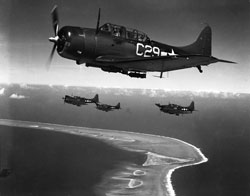 The SBD (the abbreviation stands for Scout/Bomber/Douglas) has delightfully light, fabric-covered ailerons, and it is well balanced and obedient across the middle part of its speed range. The airplane’s never-exceed speed is a ridiculously high 425 miles an hour. “Economy cruise”—a misnomer in an airplane that drinks 60 gallons of fuel an hour at its most efficient cross-country power setting—shows about 170 mph indicated.
The SBD (the abbreviation stands for Scout/Bomber/Douglas) has delightfully light, fabric-covered ailerons, and it is well balanced and obedient across the middle part of its speed range. The airplane’s never-exceed speed is a ridiculously high 425 miles an hour. “Economy cruise”—a misnomer in an airplane that drinks 60 gallons of fuel an hour at its most efficient cross-country power setting—shows about 170 mph indicated.
In the “Handling Characteristics” portion of the SBD manual, a scant few paragraphs tell only that its flying qualities are “normal for airplanes of this type.” It also warned that the left wing tends to drop in a stall. Buckley made a textbook overhead approach and landing, shut the airplane down, and told me it was my turn to get in front.
Strapping into the SBD for the first time, a few things jump out. First, the cockpit itself is massive and roomy. The sliding canopy, left open during ground operations—including takeoff and landing—accentuates the feeling of open space around you. Then, when you look at the instrument panel, you quickly realize that nothing is quite where you expect it to be. The SBD was designed long before cockpit standardization, so it takes time to figure out where the proper dials and levers are hidden. The landing gear and hydraulic system handles, for example, are on the right side of the cockpit. And the dive brake handle is right next to the flap handle. The propeller lever is on the back side of the throttle quadrant. And the switch that controls the cowl flaps is next to (and looks just like) the magneto switch. It would be real easy to attempt to close the cowl flaps and inadvertently shut down the engine!
The cockpit’s dominant feature is a sliding navigation table that emerges from the instrument panel. The plotting board is about the same size as an airline tray table, and it sits right in the pilot’s lap. Fortunately, this airplane has a GPS, so I wouldn’t need the giant whiz wheel. But the plotting board hints at the navigational skills wartime SBD pilots needed to find their way to and from targets.
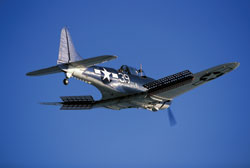 Throughout the process of joining the CAF, the Dixie Wing, and the flight evaluations, I always suspected that there was a catch. The CAF has long had a reputation as a flying club for airline and former military pilots, and a GA pilot like me could never really get the keys to an airplane. During the long scavenger hunt required to collect the necessary approvals, I never let myself get too excited about flying the SBD because I didn’t want to be crestfallen when I inevitably discovered a disqualifier in the fine print. Now all that was behind me. I was actually taxiing this historic airplane to the runway. Each of the Wright’s nine cylinders puts out more horsepower than the entire engine of the Cessna 150 I had first soloed.
Throughout the process of joining the CAF, the Dixie Wing, and the flight evaluations, I always suspected that there was a catch. The CAF has long had a reputation as a flying club for airline and former military pilots, and a GA pilot like me could never really get the keys to an airplane. During the long scavenger hunt required to collect the necessary approvals, I never let myself get too excited about flying the SBD because I didn’t want to be crestfallen when I inevitably discovered a disqualifier in the fine print. Now all that was behind me. I was actually taxiing this historic airplane to the runway. Each of the Wright’s nine cylinders puts out more horsepower than the entire engine of the Cessna 150 I had first soloed.
My mouth was dry by the time I made my first radio transmission announcing that Douglas Eight-Two-Golf-Alpha was about to take off from Runway 31. I stowed the laminated checklist, then double-checked the abbreviated “cheat sheet” engraved on the left side of the canopy frame. Fuel selector on the left main tank, fuel pump on, flaps up, trim set, low blower, prop full forward, canopy open, cowl flaps open, tailwheel locked. As the throttle went forward, the noise level was jarring. Each time the growling propeller made me think I was at full power, a glance at the manifold pressure gauge told me to keep pushing. I kept the tail low, and the airplane surged off the runway. I tried to keep the pitch steady as I transferred the stick to my left hand and raised the landing gear with my right. Then I reduced the power to 35 inches, brought the prop back to 2,300 rpm from 2,500, and configured the airplane for a cruise climb. There was surprisingly little wind in my face as the plane accelerated to 180 miles an hour, but tiny whirlwinds tugged and snapped at my shirtsleeves.
Over the farm fields south of Atlanta, I went through the same maneuvers that Buckley and I had practiced an hour earlier. With the dramatically improved visibility in the front cockpit and the additional information the instruments provided, placing the airplane where I wanted it seemed almost second nature—even though I was so new to it. After about 30 minutes of flying, it was time to try to put the Dauntless back on the ground. The prelanding cheat sheet on the right side of the canopy frame kept me from leaving out anything critical: fuel pump on, landing gear down, tailwheel locked, flaps down, prop full forward. Final approach was 85 miles an hour, and the controls felt light and positive even as the airspeed gradually diminished. Crossing the fence at 80 miles an hour, a slight flare, then the airplane’s main landing gear touched down—and I pinned them on with forward stick.
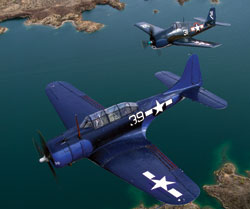 The tailwheel didn’t have far to fall since the SBD stands at a relatively flat attitude, and I let it roll the full length of the 5,000-foot runway. The SBD tends to roll straight, but applying the brakes requires jabs to the top part of the rudder pedals. After three takeoffs and full-stop landings, I was ready to consider my first solo hour in the SBD a success.
The tailwheel didn’t have far to fall since the SBD stands at a relatively flat attitude, and I let it roll the full length of the 5,000-foot runway. The SBD tends to roll straight, but applying the brakes requires jabs to the top part of the rudder pedals. After three takeoffs and full-stop landings, I was ready to consider my first solo hour in the SBD a success.
During the next few airshow seasons, I got to fly the Dauntless to events in Texas, South Carolina, Michigan, Ohio, and Florida. On my very first fuel stop after a four-hour leg from Atlanta, I was shocked to find the oil level in the Dauntless down almost four gallons. Not quarts— gallons. The left wing root was coated in a film so slippery that just standing on it was treacherous. I called back to the hangar and asked crew chief Dickerson whether to ground the plane right there. In his soothing voice, he reminded me of the first thing he told me about Wright engines: Oil was cheap and soap was cheap. Remember?
At airshows, I’d meet people with personal connections to the airplane. Some had flown SBDs as pilots or gunners, others had family members who built or worked on them. All had stories, some funny, some tragic. In the telling, it didn’t take much imagination to recognize youthful twenty-somethings peering out through octogenarian eyes.
Flying the SBD was thrilling and confidence building from a stick-and-rudder standpoint. But much more significant, the SBD animates the historical sweep of U.S. naval aviation, recognizes its unique place in our national life, and honors the people who have dedicated their lives to it—both then and now.
Anchors aweigh.
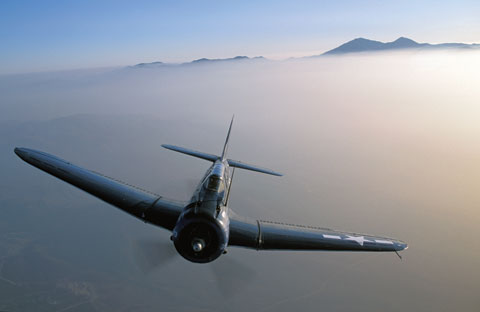
E-mail the author at [email protected]. Photography by Paul Bowen



